RESTORATION CENTER
Founded in 1997 by Alex Brusilovsky, West End Pianos has been devoted to music with an emphasis in performance level service. Because of this, it has become a well-established and highly respected piano restoration and rebuilding company.
I specialize in vintage Steinway, Mason & Hamlin, Bluthner, Knabe, Chickering, Baldwin and many other pianos.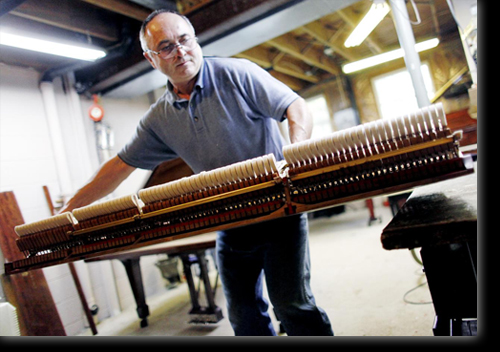
The piano restoration process starts with a high quality, hand crafted grand piano built by the original namufacturer to a high degree of percision and nearly perfect design.
A properly restored/rebuilt piano will regain its original grandeur and value, often superior to a new instrument of comparable value.
Quality replacement materials coupled with high quality workmanship will result in a restored instrument that will last as long or longer than the original piano.
Rebuilding a good, quality made piano will increase its value in most cases more than two-fold.
Not only can piano restoration be a financial investment, it can also supply a lifetime of music enjoyment that can be passed down from generation to generation.
Because of the piano restoration center's combined experience, expertise and the use of quality materials, restored pianos are an investment of a lifetime.
Dismantle
Piano restoration starts with the dismantling of the instrument. Notes and measurements are taken during this process to aid the assembly process. Each piano is assigned a number in order to monitor the piano and its progress. During the dismantling process, each piano part is placed in a designated area.
Refinishing
At the start of the piano refinishing process, the case and the parts of the instrument are stripped of the original finish, then repaired and sanded as necessary to prepare the surface for new finish.
Finish application involves many steps, including: staining, then sealing the stain for wood finishes, filling the wood grain, sealing in the filler for clear finish or applying surface primer for ebony finishes, then applying multiple coats of ebony or clear lacquer, and sanding between coats.
After the final coats have been applied, the finish must cure for a minimum of 20 days before the rub out process begins. This process involves careful block sanding of the surface with fine sand paper for evenness, hand polishing with #0000 steel wool, and using polishing compounds to achieve the desired luster.
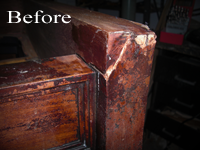
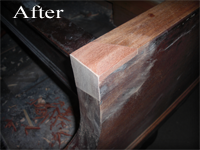

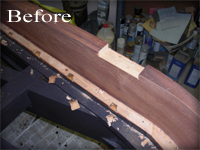
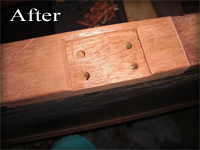
Soundboard
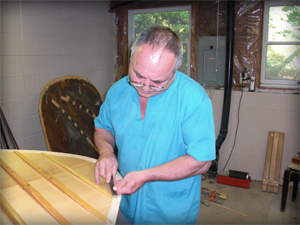 The soundboard is the heart
of the piano; superb tone quality, rich and resonant sound is the fruit of a high-quality, perfectly constructed board.
The soundboard is the heart
of the piano; superb tone quality, rich and resonant sound is the fruit of a high-quality, perfectly constructed board.
Quarter-sawn, fine-grained solid spruce is used to replace soundboards with cracks and no crown. All new soundboards and ribs are crowned. Each board is dried to insure a minimum moisture content of 5-6%. A specialty at West End Piano Restoration, the art of soundboard construction and installation has been studied and perfected in our shop..
Pinblock
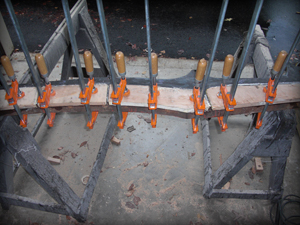 As a critical part in determining the longevity of the piano, the pinblock must be strong enough to tolerate 20 tons of string pressure and to hold
the pins tightly.
As a critical part in determining the longevity of the piano, the pinblock must be strong enough to tolerate 20 tons of string pressure and to hold
the pins tightly.
Highest quality multi-laminate maple or beech is used to replace worn and cracked pinblocks.
Bridges
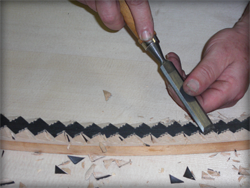 The bridges of the piano are not only a medium to transfer string energy to the soundboard, they also keep the strings stable. To handle the pressure of the strings, the bridges must be made of the hardest possible wood.
The bridges of the piano are not only a medium to transfer string energy to the soundboard, they also keep the strings stable. To handle the pressure of the strings, the bridges must be made of the hardest possible wood.
Bridges are recapped with rock maple wood, cut from high quality straight grain planks. They are hand chiseled for a precise determination point for string positioning.
Cast Iron Frame
The strings are attached to the cast-iron frame. Therefore the frame must withstand approximately 20 tons of string tension. Great care in handling and storing the frame is maintained until it is reinstalled into the piano casing just prior to stringing.
The frame is carefully sanded, undercoated, rebronzed and hand lettered. The agraffes are removed, cleaned and carefully inspected for defects and damage before installing. Defective agraffes are replaced.
Strings
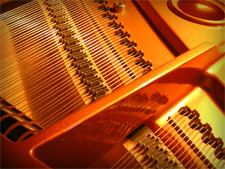 The final phase of the inside piano rebuilding process is the stringing of the piano. The finest German Roslau steel strings are used. The bass strings are duplicated to the accurate specifications required by each instrument.
The final phase of the inside piano rebuilding process is the stringing of the piano. The finest German Roslau steel strings are used. The bass strings are duplicated to the accurate specifications required by each instrument.
Action
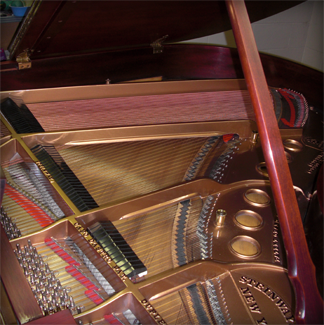 The total amount of piano action restoration is dependent upon the amount of use or misuse the piano has had. Felts hardened with age and pressure, or worn and moth eaten must be replaced to insure a quiet and smooth playing action. Only the finest quality felts are used.
The total amount of piano action restoration is dependent upon the amount of use or misuse the piano has had. Felts hardened with age and pressure, or worn and moth eaten must be replaced to insure a quiet and smooth playing action. Only the finest quality felts are used.
Action replacement parts by Renner are chosen for their high quality, exactness and longevity. Key and key frame replacement, should that be needed will be from the manufacturer best suited to fit the need.
Keys
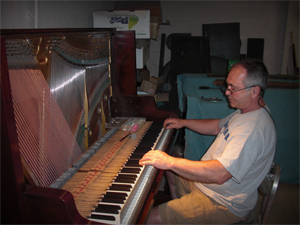 Key work and leveling is the foundation of a solid and lasting action regulation. The keysticks and frame are thoroughly cleaned and repaired. Felt bushings and frame rail felts are replaced to insure precise and quiet key movement.
Key work and leveling is the foundation of a solid and lasting action regulation. The keysticks and frame are thoroughly cleaned and repaired. Felt bushings and frame rail felts are replaced to insure precise and quiet key movement.
Often the key stick needs repair. This involves a re-wooding process that returns widened key spacing to the correct original specifications. Widened key spacing is caused by improper top replacement and wood shrinkage.
Key top replacement choices include fine grade acrylics, legal ivory, pre-historic mammoth tusk ivory and bone. Sharps of original solid ebony are reshaped and sealed. Replacements choices are solid ebony, rosewood/ebony and plastic resin.
Regulation
By properly adjusting all the moving parts, the piano regulation process will give the piano responsiveness to the touch, even and precise control. Great care is given to be sure that all specifications are fulfilled. This process is often repeated up to three times.
Hammers
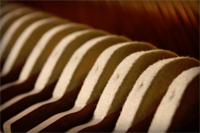 The quality of hammer is
critical for bringing out the instrument's most beautiful tone. Only the highest quality available hammers with long-grain wool fibers
are used. My suppliers are from the US and Germany. Hammers made by Renner are often our first choice.
The quality of hammer is
critical for bringing out the instrument's most beautiful tone. Only the highest quality available hammers with long-grain wool fibers
are used. My suppliers are from the US and Germany. Hammers made by Renner are often our first choice.
Voicing
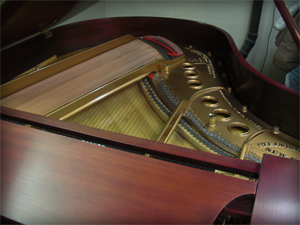 After installation and action regulation, a meticulous voicing of the hammers is completed. This process, involving softening and/or hardening of the hammers, brings out the full tonal beauty and resonance of the instrument.
After installation and action regulation, a meticulous voicing of the hammers is completed. This process, involving softening and/or hardening of the hammers, brings out the full tonal beauty and resonance of the instrument.
Assembly
One can be assured that I will take great pride in your piano restoration work, and that the proper repairs are completely and carefully made.
Upon completion each piano is assembled and inspected to insure that all aspects of the piano restoration are perfect.